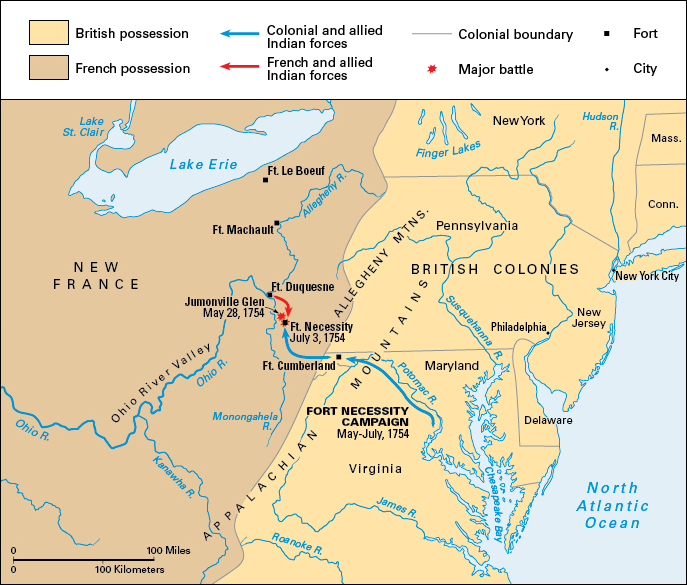Fort Necessity campaign was a series of military operations at the start of the French and Indian War (1754-1763). The campaign was fought in what is now southwestern Pennsylvania between May and July 1754. George Washington, at that time a young colonel in the Virginia colonial militia, led a British-allied force against a larger French army. Washington and his men had built Fort Necessity, a circular wooden fort, to prepare for a French invasion. French troops forced the defenders of the fort to surrender.
Background.
British and French forces in North America had clashed in a series of wars dating back to 1689. Both sides fought with the support of American Indian allies. The fighting centered on territorial claims and the control of fur-trading networks and militarily strategic locations. See French and Indian wars .

By the early 1750’s, the French and British were moving to secure fur-trading rights in the Ohio River Valley. The French began to build forts to protect their networks of alliances and trade west of the Appalachian Mountains. The French had claimed the Ohio River, which provided transportation between their possessions in Canada and in Louisiana. The British had interest in the fur trade, but they also wished to open new lands to British settlement. In 1749, the Ohio Company of Virginia, a group of land speculators and colonial officials, had received a royal grant for more than 200,000 acres (81,000 hectares) in the Ohio Valley.
In late 1753, acting Virginia governor Robert Dinwiddie sent 21-year-old George Washington to carry a message to two French forts near Lake Erie. Dinwiddie demanded that the French abandon their forts and return to Canada. The commanders of the forts replied that they were under no obligation to leave, and Washington returned to Virginia.
Fort Duquesne.
Early in 1754, Dinwiddie ordered Virginia provincial troops to build a fort at the point where the Allegheny and Monongahela rivers join to form the Ohio River. The location is the site of present-day Pittsburgh. In March, Dinwiddie ordered Washington to reinforce the fort with Virginia soldiers. However, before Washington could arrive, he learned that the French had driven off the fort’s few defenders. The French built a larger fort at the site and called it Fort Duquesne. Washington and his men continued toward the fort.
Jumonville Glen.
In late May, Washington and his men camped in an area called Great Meadows, about 70 miles (113 kilometers) southeast of Fort Duquesne. Washington soon learned that French soldiers were camped in a glen (small, narrow valley) nearby.
On the night of May 27, Washington and about 40 Virginians and Iroquois allies marched to the glen. They surrounded the French camp early the next morning. Shots were fired—the first shots of the French and Indian War. In a short battle, the Washington’s men killed as many as 13 French soldiers and captured 21. One colonial soldier was killed. The French leader, Ensign Joseph Coulon de Villiers de Jumonville, was wounded in the action. According to some accounts, Tanaghrisson, an Iroquois leader also known as the Half King, killed the wounded Jumonville after the battle. The area became known as Jumonville Glen.
Controversy arose over the fighting at Jumonville Glen. French survivors claimed they had been on a diplomatic mission, and the French accused Washington of assassinating Jumonville. Washington believed the Frenchmen had behaved more like spies than diplomats.
Fort Necessity.
Washington and his men, anticipating a strong French counterattack, built a circular wooden fort at Great Meadows. They called it Fort Necessity.
In early June, additional Virginia soldiers arrived at the fort. About 100 British regulars from South Carolina arrived several days later. Washington now commanded a force of nearly 400 men. While the South Carolina regulars remained at the fort, Washington and the Virginians forged a road toward a settlement to the north. But Washington returned to the fort after learning that a large French and Indian force was marching toward Great Meadows.
On July 3, an army of about 600 French soldiers and 100 Indian warriors, led by Jumonville’s brother, approached the fort. The French-allied force fired from behind rocks and trees. They killed about 30 of Washington’s men and wounded about 70. Rain soon muddied the battlefield. Fort Necessity’s gunpowder stores became damp, rendering the defenders’ guns useless. Food and other supplies ran low.
Around midnight, Washington agreed to terms of surrender. The French allowed the British-allied force to march from the fort. The French let Washington’s men keep their guns but ordered them to leave behind some small cannons. Washington returned to Virginia.
Aftermath.
The French burned Fort Necessity after the battle. The British led two costly campaigns against Fort Duquesne in 1755 and 1758. The French abandoned and burned that fort in late 1758. The French and Indian War ended in 1763 with the signing of the Treaty of Paris. Under the terms of the treaty, the French surrendered nearly all their possessions in North America.
See also Fort Duquesne, Battles of ; Fort Necessity ; Pittsburgh (History) ; Seven Years’ War ; Washington, George (Surrender of Fort Necessity) .
